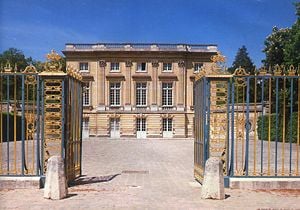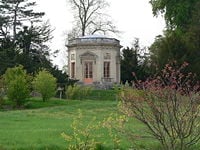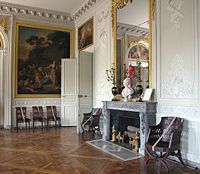Petit Trianon
The Petit Trianon is a château and museum located on the grounds of the Palace of Versailles in Versailles, France. It was designed and completed in 1768 by the renowned French architect Ange-Jacques Gabriel during the reign of Louis XV. However, it was during the reign of Louis XVI and Marie Antoinette that it became the unofficial residence for the Queen Consort and her children who preferred its private and pastoral setting to the largesse and formality of the royal court.
Marie Antoinette often sought refuge at the Petit Trianon where she attempted to re-create the intimate musical and theatrical productions of her childhood with her retinue of friends and family. All protocol regarding admittance to the property was de par la Rein (by order of the Queen); meaning even the King needed express permission to enter. However, such exclusivity alienated the court nobility and proved threatening and secretive to her royal subjects, the people of France.
While historians have pointed to Marie Antoinette's excesses as a cause of the French Revolution, there can be no doubt that a legacy of beauty, art and design, as exemplified by the Petit Trianon's classical structure, was bequeathed to subsequent generations of Europeans. This enduring testament to French culture, enjoyed by tourists today, includes paintings, time period furnishings, many object d'arts and flowering botanical gardens.
Background
Modeled after the Grand Trianon and built nearly a hundred years later, the Petit Trianon, was to serve a similiar purpose: to provide a retreat and hideway from life within the Royal court and main palace. Originally, intended for Louis XV's mistress Madame Pompadour, who died before its completion, it was then bequeathed to her successor Madame Du Barry. In 1774, the 20-year-old Louis XVI, upon his accession to the throne, gave the château and its surrounding park to his 19-year-old Queen Marie Antoinette for her exclusive use and enjoyment.
The chateau, along with its outer buildings, was built near a lake, and was meant to resemble a small rural village. On its pastoral grounds sheep meandered, wild flowers were grown and picked by Marie Antoinette and her children and cows were milked. There Marie Antoinette and her entourage could enjoy favorite past times reminiscent of Marie Antoinette's own Austrian childhood such as staging small operas and theatrical productions. Marie Antoinette, along with others in her inner circle such as the Princess de Lamballe enjoyed a respite from court life that came to an unseemly end when the French Revolution sought to extinguish the excesses of absolute monarchism.
Architecturural Style
The château of the Petit Trianon is a celebrated example of the transition from the Rococo style of the earlier part of the 18th century, to the more formalized Neoclassical architectural style which became vogue in the late 17th and 18th century. The exterior of the château is elegant, almost austere, in its simplicity. The chateau's originality is expressed by its four sides or facades, each thoughtfully designed according to the part of the estate it would face. The Corinthian order of columns is the dominant decorative feature of the chateau, with two detached and two semi-detached pillars on the side of the formal French garden, and pilasters facing both the courtyard and the area once occupied by Louis XV's greenhouses. Overlooking the former botanical garden of the king, the remaining facade was left bare. The subtle use of steps compensates for the differences in level due to the château's inclined location.
Inner Rooms
Reflecting Marie Antoinette's almost obsessive need for privacy, the building was designed to require as little interaction between guests and servants as possible. To that end, the table in the salles à manger was originally designed to be mobile, that is mechanically lowered and raised through the floorboards so that the servants below could set places sight unseen. The tables were never built, but the delineation for the mechanical apparatus can still be seen from the foundation.
Within the queen's apartment one sees a reflection of Marie Antoinettes love for simplicity and flowers and her favorite colors of ..... the decor of her boudoir displays an inventiveness unique to the age, featuring mirrored panels that, by the simple turning of a crank, can be raised or lowered to obscure the windows. Her bedroom's furniture; French provincial style from Georges Jacob and Jean Henri Riesener. The wallpaper was painted by Jean-Baptiste Pillement
Exhibits
Moberly-Jourdain incident
The Moberly-Jourdain incident is alleged to have occurred on 10 August, 1901 in the gardens of the Petit Trianon. In 1911, two English academics, Charlotte Anne Moberly and Eleanor Jourdain, pseudonymously published a book entitled An Adventure, in which they claimed to have experienced a time slip during a visit to the Petit Trianon, and seen Marie Antoinette as well as many other people of the same period. The book caused a sensation with the public despite dismissal by critics.
Notes
ReferencesISBN links support NWE through referral fees
- Views and Plans of the Petit Trianon at Versailles Arizzoli-Clementel, Pierre; Ducamp, Emmanuel; Chatelet, Claude-Louis Recueil. France: Hardcover Publisher, Alain De Gourcuff. 1998. ISBN 9782909838304
- Fraser, Antonia. Marie Antoinette: The Journey. New York: Anchor Books, 2001. Reprint edition, 2006. ISBN 075381305X
- Marvin Trachtenberg and Isabelle Hyman. Architecture, from Prehistory to Post-Modernism. Englewood Cliffs, NJ: Prentice-Hall, 1986. ISBN 0-13-044702-1.
External links
Template:Commonscat-inline
- Official site
- The Petit Trianon in Quicktime VR. Chateau de Versailles.
- Ancient Places TV: HD Video of The Queen's Hamlet at the Petit Trianon
- Marie Antoinette and the French Revolution
- Marie-Antoinette and the Petit Trianon at Versailles
- MARIE ANTOINETTE’S PETIT TRIANON COMES TO SAN FRANCISCO
- Le Petit-Trianon histoire et description
- Great Buildings: Let Petit Trianon Retrieved August 9, 2008.
- Virtourist.com Retrieved August 9, 2008.
Credits
New World Encyclopedia writers and editors rewrote and completed the Wikipedia article in accordance with New World Encyclopedia standards. This article abides by terms of the Creative Commons CC-by-sa 3.0 License (CC-by-sa), which may be used and disseminated with proper attribution. Credit is due under the terms of this license that can reference both the New World Encyclopedia contributors and the selfless volunteer contributors of the Wikimedia Foundation. To cite this article click here for a list of acceptable citing formats.The history of earlier contributions by wikipedians is accessible to researchers here:
The history of this article since it was imported to New World Encyclopedia:
Note: Some restrictions may apply to use of individual images which are separately licensed.


